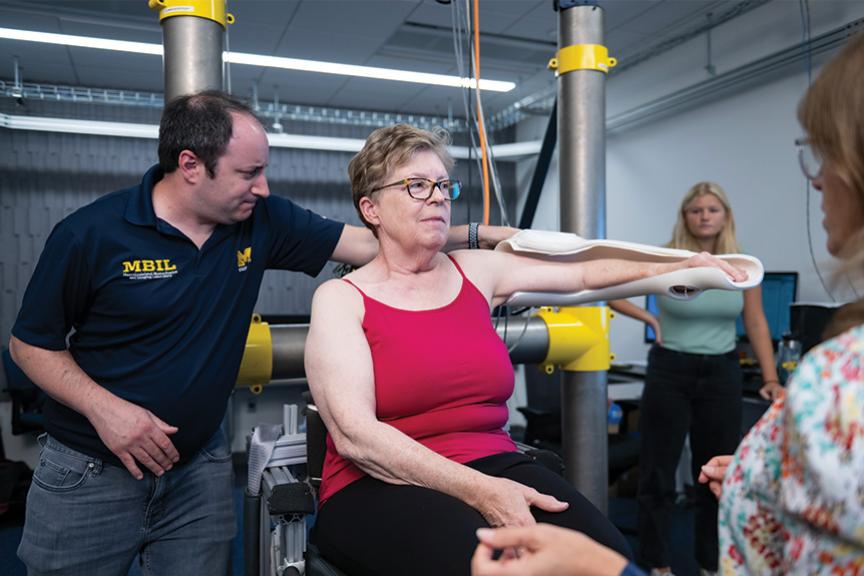
 Back to News
Back to News
Understanding the effects of breast reconstruction surgery

David Lipps, associate professor of Movement Science and director of the Musculoskeletal Biomechanics and Imaging Laboratory, examines how breast cancer treatments impact muscle quality, particularly in the shoulder and arms.
His previous studies focused on understanding the effects of radiation treatment on shoulder and muscle stiffness and how patients move their arms during daily activities. Lipps said while radiation removes the cancer cells, shoulder muscles beneath the breast tissue receive incidental radiation doses that may damage the muscle tissue and, ultimately, the ability to use the arm.
He also said breast reconstruction surgery can alter the structure and function of shoulder muscles, as the pectoralis muscle is cut to place a subpectoral implant that restores the natural look and feel of the breast.
“Implants are placed beneath the pectoralis muscle, and oftentimes in these surgeries there isn’t much done to reattach the muscle to the musculoskeletal system,” Lipps explained. “The muscle is still intact on the sternum and clavicle, but the bottom of the muscle is removed off the ribs.”
Now, his lab is trying to understand how breast reconstruction surgery affects patients’ ability to use their shoulders and arms during everyday living.
A study authored by Joshua Leonardis (MVS PhD ‘20), PhD student Whitney Wolff, Michigan Medicine Professor of Surgery Adeyiza Momoh, and Lipps focused on how patients adapt to breast reconstruction surgery. The team was particularly interested in examining how arm dominance affects clinical outcomes in women undergoing mastectomy and breast reconstruction on both sides of their body.
Small surface electrodes placed on a patient’s muscles surrounding the shoulder joint allowed the group to examine different muscle activations. The study discovered that patients were “adopting neuromuscular compensation strategies to maintain shoulder function” on their dominant arm but not on their non-dominant one.
“This study gives us important insights into how the brain recruits muscles around the shoulder after surgery and points to how the brain recruits muscles differently for the dominant arm versus the non-dominant one,” said Lipps.
He added that further examination is needed to understand whether it’s good or bad that these adaptations are only occuring on a patient’s dominant arm due to the loss of functional abilities from the pectoralis muscle.
Lipps would also like to see his lab develop interventions for patient rehabilitation care.
“We’re starting to see the importance of arm dominance on clinical outcomes after breast cancer surgery thanks to this study. This could impact whether or not people need rehabilitation and lead us to include aspects of dominance in our intervention recommendations,” Lipps said.
Lipps is also interested in understanding how new surgical approaches to reconstruction can potentially lessen shoulder morbidity. A grant from the American Cancer Society will help his team research the functional benefits of surgeons performing pre-pectoral reconstruction surgeries (which don’t involve cutting any shoulder muscles). His goal is to compare the functionality of patients who underwent pre-pectoral surgery versus those who received subpectoral implants.
“Theoretically, the functional use of our arm is maintained after a pre-pectoral surgery, but there is no quantitative data to support that,” he said.
Lipps added this could potentially remove the need for any rehabilitation. “If you correct the surgery, then you don’t have to worry about the rehab part at the end,” he said.
Learn more about Lipps’s lab and work at myumi.ch/y9gE2.